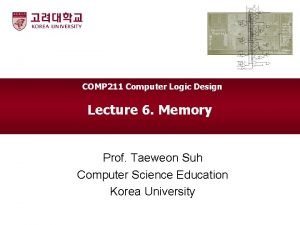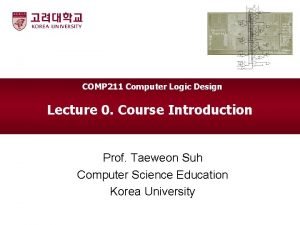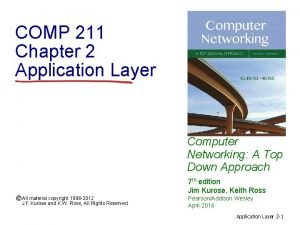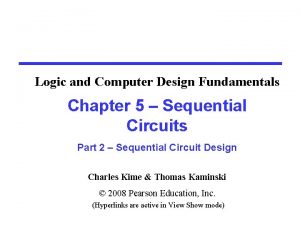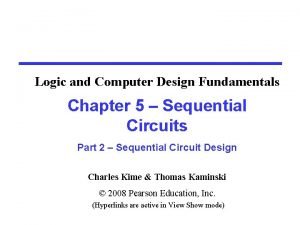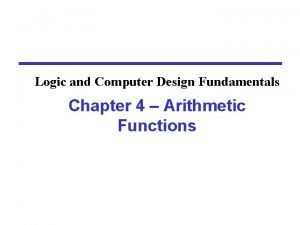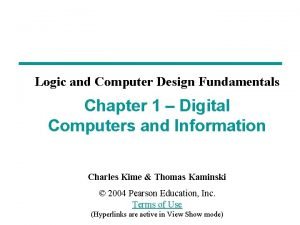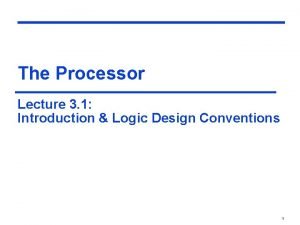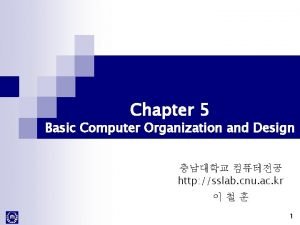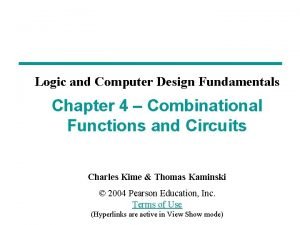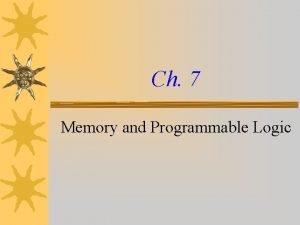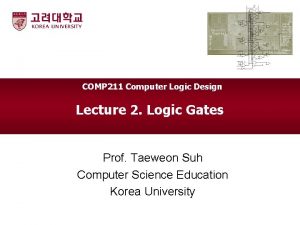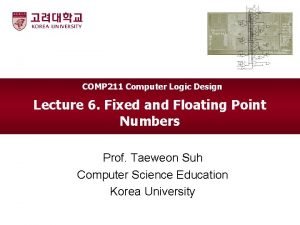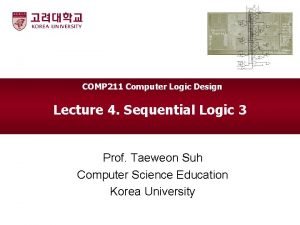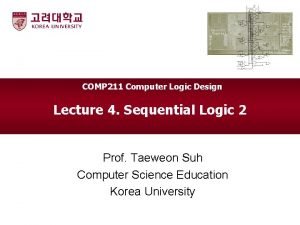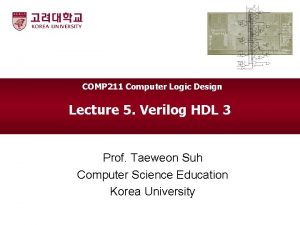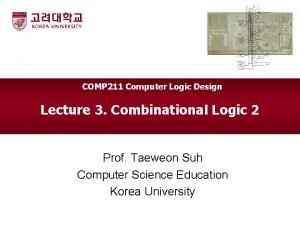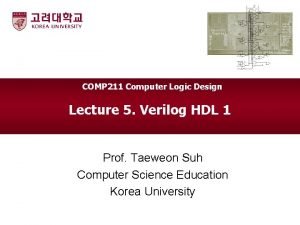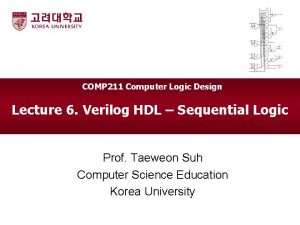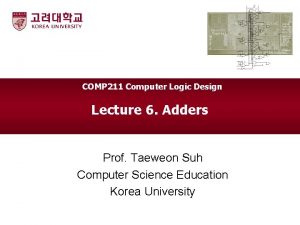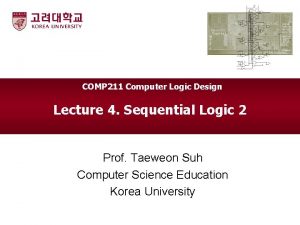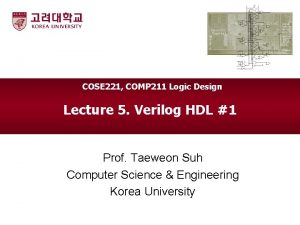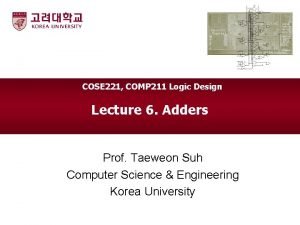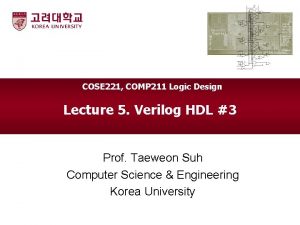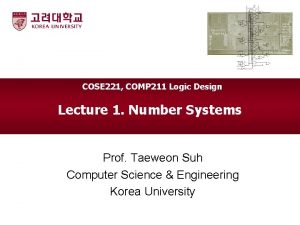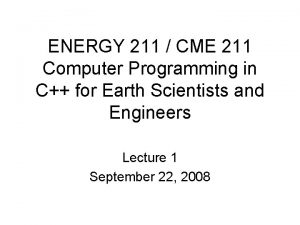COMP 211 Computer Logic Design Lecture 6 Memory






























- Slides: 30

COMP 211 Computer Logic Design Lecture 6. Memory Prof. Taeweon Suh Computer Science Education Korea University

Memory • Digital systems including computer systems require memories § Memory is used to store instructions and data • Registers (made from flip-flops) are kind of memory § But, how many transistors need to build a 1 -bit register (that is, to store 1 -bit) with a flip-flop? • Here we study memory arrays that can efficiently store large amounts of data § RAM and ROM 2 Korea Univ

Memory • Random Access Memory (RAM) § Static Random Access Memory (SRAM) • • Data stored so long as power is applied 6 -transistors per cell Faster Differential § Dynamic Random Access Memory (DRAM) • • Require periodic refresh Smaller (can be implemented with 1 or 3 transistors) Slower Single-Ended § Can be read and written • Read-Only Memory (ROM) Modified from Prof Sean Lee’s Slide, Georgia Tech 3 Korea Univ

Examples • DDR SDRAM (Double Data Rate Synchronous DRAM) § Widely being used for main memory in computers 4 Korea Univ

Block Diagram of Memory • An M-bit data value can be read or written at each unique N-bit address lines N Read/Write Memory 2 N words • Example: Byte-addressable 2 MB memory § M = 8 (because of byteaddressability) § N = 21 (1 word = 8 -bit) (M-bit per word) Chip Select (Chip Enable) M M-bit Data Output (for Read/Write) Modified from Prof Sean Lee’s Slide, Georgia Tech 5 Korea Univ

Memory Organization Example 2 -to-4 4 words x 8 bits Wordline (WL) 0 Decoder 1 -bit 1 -bit 1 -bit 1 -bit 1 -bit 1 -bit 1 -bit 1 -bit 1 A 0 2 A 1 3 CS Chip Select D 7 D 6 Modified from Prof Sean Lee’s Slide, Georgia Tech D 4 D 5 6 D 3 D 2 D 1 D 0 Bit. Line Korea Univ

How to Address Memory 2 -to-4 A 0=1 4 words x 8 bits 0 Decoder 1 -bit 1 -bit 1 -bit 1 -bit 1 -bit 1 -bit 1 -bit 1 -bit 1 2 A 1=0 3 CS Chip Select=1 D 7 D 6 D 4 D 5 D 3 D 2 D 1 D 0 Access address = 0 x 1 Modified from Prof Sean Lee’s Slide, Georgia Tech 7 Korea Univ

Static Random Access Memory (SRAM) • Typically each bit is implemented with 6 transistors (6 T) • Read operation § § § • The bitline and its inverse are precharged to Vdd (1) Then set Wordline (WL) high Depending on the value stored, either bitline or ~bitline goes low Write operation § § Put the (strong) new value on Bitline and its inverse on ~Bitline Then set the Wordline to high Wordline (WL) Bit. Line Modified from Prof Sean Lee’s Slide, Georgia Tech 8 Bit. Line Korea Univ

Dynamic Random Access Memory (DRAM) • 1 -transistor DRAM cell • Write operation § • Read operation § § • Put a (strong) new value on bitline and then set WL=1 Precharge bitline to Vdd (1) Assert WL to 1 Storage decays, thus requires periodic refreshing § Read bitline data and write it periodically to keep the value in the memory cell Wordline (WL) Bitline Modified from Prof Sean Lee’s Slide, Georgia Tech 9 Korea Univ

Memory Description • Capacity of a memory is described as § # addresses x Word size • Examples: Memory # of addr # of data lines # of addr lines # of total bytes 1 M x 8 1, 048, 576 8 20 1 MB 2 M x 4 2, 097, 152 4 21 1 MB 1 K x 4 1024 4 10 512 B 4 M x 32 4, 194, 304 32 22 16 MB 16 K x 64 16, 384 64 14 128 KB 10 Korea Univ

Example 11 Korea Univ

Memory with 2 Decoders 2 -to-4 8 words x 4 bits 0 1 -bit 1 -bit 1 -bit 1 -bit 1 -bit 1 -bit 1 -bit 1 -bit 1 A 1 Row Decoder 2 A 2 3 CS Chip Select 1 -bit Tristate Buffer D 0 (read) CS 0 1 -to-2 Column Decoder 1 D 2 D 3 A 0 Modified from Prof Sean Lee’s Slide, Georgia Tech 12 Korea Univ

Read Operation 2 -to-4 A 1 8 words x 4 bits 0 1 -bit 1 -bit 1 -bit 1 -bit 1 -bit 1 -bit 1 -bit 1 -bit 1 Row Decoder 2 A 2 3 CS Rd/Wr = 0 Chip Select CS 0 1 -to-2 Column Decoder 1 D 0 D 1 D 2 D 3 A 0 = 0 Modified from Prof Sean Lee’s Slide, Georgia Tech 13 Korea Univ

Write Operation 2 -to-4 A 1 8 words x 4 bits 0 1 -bit 1 -bit 1 -bit 1 -bit 1 -bit 1 -bit 1 -bit 1 -bit 1 Row Decoder 2 A 2 3 CS Rd/Wr = 1 Chip Select CS 0 1 -to-2 Column Decoder 1 D 0 D 1 D 2 D 3 A 0 = 1 Prof. Sean Lee’s Slide, Georgia Tech 14 Korea Univ

Building Memory in Hierarchy • Design a 1 Mx 8 using 1 Mx 4 memory chips D 7 D 6 1 Mx 4 D 5 R/W CS A 19 A 18 A 17 D 3 D 2 1 Mx 4 CS A 0 Prof. Sean Lee’s Slide, Georgia Tech D 4 D 1 R/W CS 15 D 0 Korea Univ

Building Memory in Hierarchy • Design a 2 Mx 4 using 1 Mx 4 memory chips A 19 A 18 A 17 D 3 D 2 1 Mx 4 D 0 A 20 1 -to-2 Decoder D 1 CS R/W 1 0 CS A 19 A 18 A 17 1 Mx 4 A 0 Prof. Sean Lee’s Slide, Georgia Tech CS 16 R/W Korea Univ

Building Memory in Hierarchy • Design a 2 Mx 8 using 1 Mx 4 memory chips A 19 A 18 A 17 A 0 A 20 1 -to-2 Decoder 1 D 7 A 19 A 18 A 17 CS A 0 A 19 A 18 A 17 Prof. Sean Lee’s Slide, Georgia Tech A 0 R/W D 4 D 2 1 Mx 4 CS D 1 R/W D 0 1 Mx 4 CS A 0 A 19 A 18 A 17 D 5 D 3 A 0 CS D 6 1 Mx 4 R/W 1 Mx 4 17 CS R/W Korea Univ

Verilog Representation of RAM • RAM (synchronous with clock) `timescale 1 ns / 1 ns module ram #(parameter N (input [N-1: 0] input [M-1: 0] output [M-1: 0] = 8, M = 32) clk, we, adr, din, dout); reg [M-1: 0] mem[2**N-1: 0]; always @(posedge clk) if (we) mem[adr] <= din; assign dout = mem[adr]; endmodule ram_tb(); reg clk; reg we; reg [7: 0] addr; reg [31: 0] din; wire [31: 0] dout; parameter clk_period = 10; ram_uut(. clk (clk), . we (we), . adr (addr), . din (din), . dout (dout)); always begin clk = 1; forever #(clk_period/2) clk = ~clk; end initial begin addr addr = = = 4'h 00; 4'h 02; 4'h 09; 4'h 34; addr = = 4'h 09; 4'h 02; 4'h 34; 4'h 00; we we we = = = 1'b 0; 1'b 1; 1'b 0; din din din = = = 32'h 0000; 32'h 00001111; 32'h 22223333; 32'h 9999 AAAA; 32'h 3434; #3; #(clk_period*1); #(clk_period*1); #(clk_period*1); endmodule 18 Korea Univ

Read-Only Memory (ROM) • Non-volatile memory § Permanent binary information is stored § Power off does not erase information stored K-bit address lines K Prof. Sean Lee’s Slide, Georgia Tech ROM N-bit Data Output 2 k words (N-bit per word) 19 N Korea Univ

32 x 8 (32 words x 8 bits) ROM • 8 To read the cell, the bitline is weakly pulled HIGH. Then, the wordline is turned ON § § If the transistor is present, it pulls the bitline LOW If the transistor is not present, the bitline remanins HIGH A 4 A 3 5 32 X 8 ROM 5 -to-32 Each represents 32 wires 0 1 2 3 A 2 A 1 A 0 Decoder 28 29 30 31 D 7 D 6 Prof. Sean Lee’s Slide, Georgia Tech D 5 D 4 D 3 20 D 2 D 1 D 0 Korea Univ

Programming the 32 x 8 ROM A 4 A 3 A 2 A 1 A 0 D 7 D 6 D 5 D 4 D 3 D 2 D 1 D 0 0 0 1 1 0 0 0 1 0 1 0 1 1 0 0 … … … … 1 1 1 0 0 0 1 1 0 0 1 0 1 1 1 1 1 0 0 1 D 6 D 5 D 4 21 A 4 A 3 A 2 A 1 A 0 5 -to-32 0 1 2 Decoder 29 30 31 Prof. Sean Lee’s Slide, Georgia Tech D 7 D 3 D 2 D 1 D 0 Korea Univ

Verilog Representation of ROM • 4 X 3 (4 words x 3 bits) ROM module rom(input [1: 0] adr, output reg [2: 0] dout); always @(adr) case(adr) 2'b 00: dout 2'b 01: dout 2'b 10: dout 2'b 11: dout endcase endmodule <= <= 3'b 011; 3'b 110; 3'b 100; 3'b 010; 22 Korea Univ

Other Flavors of ROMs • Reprogrammable ROMs § EPROM (Erasable Programmable ROM) • Use UV (Ultra Violet) light for erasing § EEPROM (Electrically Erasable Programmable ROM) • Flash memory § Read and Writable § Non-volatile • Power off does not erase information stored • Modern ROMs are not really read-only § They can be reprogrammed as well • Flash memory has become extremely popular to store large amounts of data in portable systems such as cameras and music players 23 Korea Univ

Programmable Logic Array (PLA) • PLA implement two-level combinational logic in SOP form • Concept of PLA is used in the decoding stage of CPU design • Older technology A Programmable OR Plane B C Programmable AND Plane CCBBAA F 1 Modified from Prof Sean Lee’s Slide, Georgia Tech 24 F 2 Korea Univ

Example of using PLA A B C AB AC BC ABC C C B B A A Modified from Prof Sean Lee’s Slide, Georgia Tech 25 F 1 F 2 Korea Univ

FPGA • Field Programmable Gate Array (FPGA) can implement both combinational and sequential logic § PLA can implement only combinational logic • Using CAD tools, a user can implement designs on the FPGA using either HDL or schematic • It is programmable in the field § FPGA is reprogrammable (reconfigurable) after a system is deployed • 2 Major FPGA companies § Xilinx: www. xilinx. com § Altera: www. altera. com 26 Korea Univ

FPGA Examples 27 Korea Univ

The End • That’s it! Folks • I hope you have enjoyed this class • You just got one step closer to understanding computers • See you next semester in the computer architecture class 28 Korea Univ

Backup Slides 29 Korea Univ

DDR, DDR 2, DDR 3 With a 64 -bit transferred at a time, 100 MHz x 2 (DDR) X 8 Bytes = 1600 MB/sec • DDR 2 • DDR 3 30 Korea Univ
 Comp 211
Comp 211 Comp 211
Comp 211 Comp 211
Comp 211 Computer aided drug design lecture notes
Computer aided drug design lecture notes 01:640:244 lecture notes - lecture 15: plat, idah, farad
01:640:244 lecture notes - lecture 15: plat, idah, farad Jk flip flop
Jk flip flop Fundamentals of logical computing formulation
Fundamentals of logical computing formulation 010000112
010000112 Logic and computer design fundamentals
Logic and computer design fundamentals Logic design conventions in computer architecture
Logic design conventions in computer architecture Memory reference instruction
Memory reference instruction Logic & computer design fundamentals
Logic & computer design fundamentals Memory system design
Memory system design Membership function fuzzy logic
Membership function fuzzy logic Neural networks and fuzzy logic
Neural networks and fuzzy logic Fuzzy logic lecture
Fuzzy logic lecture Shape memory alloys lecture notes
Shape memory alloys lecture notes First order logic vs propositional logic
First order logic vs propositional logic First order logic vs propositional logic
First order logic vs propositional logic Third order logic
Third order logic Combinational logic circuit vs sequential
Combinational logic circuit vs sequential Cryptarithmetic problem logic+logic=prolog
Cryptarithmetic problem logic+logic=prolog 캠블리 단점
캠블리 단점 Combinational logic sequential logic
Combinational logic sequential logic Combinational logic sequential logic 차이
Combinational logic sequential logic 차이 Logic chapter 3
Logic chapter 3 Memory and programmable logic
Memory and programmable logic Semantic knowledge
Semantic knowledge Implicit memory
Implicit memory Long term memory vs short term memory
Long term memory vs short term memory Internal memory and external memory
Internal memory and external memory
